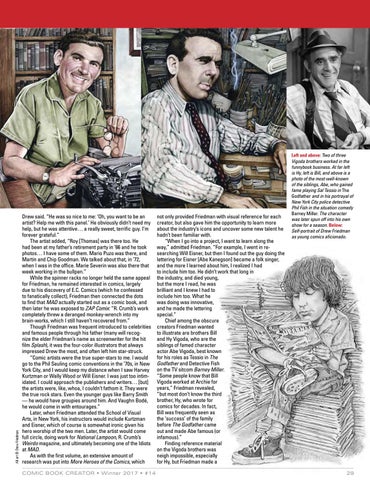All art © Drew Friedman.
Drew said. “He was so nice to me: ‘Oh, you want to be an artist? Help me with this panel.’ He obviously didn’t need my help, but he was attentive… a really sweet, terrific guy. I’m forever grateful.“ The artist added, “Roy [Thomas] was there too. He had been at my father’s retirement party in ’66 and he took photos… I have some of them. Mario Puzo was there, and Martin and Chip Goodman. We talked about that, in ’72, when I was in the office. Marie Severin was also there that week working in the bullpen.” While the spinner racks no longer held the same appeal for Friedman, he remained interested in comics, largely due to his discovery of E.C. Comics (which he confessed to fanatically collect), Friedman then connected the dots to find that MAD actually started out as a comic book, and then later he was exposed to ZAP Comix: “R. Crumb’s work completely threw a deranged monkey-wrench into my brain-works, which I still haven’t recovered from.” Though Friedman was frequent introduced to celebrities and famous people through his father (many will recognize the elder Friedman’s name as screenwriter for the hit film Splash), it was the four-color illustrators that always impressed Drew the most, and often left him star-struck. “Comic artists were the true super-stars to me. I would go to the Phil Seuling comic conventions in the ’70s, in New York City, and I would keep my distance when I saw Harvey Kurtzman or Wally Wood or Will Eisner. I was just too intimidated. I could approach the publishers and writers… [but] the artists were, like, whoa, I couldn’t fathom it. They were the true rock stars. Even the younger guys like Barry Smith — he would have groupies around him. And Vaughn Bodé, he would come in with entourages.” Later, when Friedman attended the School of Visual Arts, in New York, his instructors would include Kurtzman and Eisner, which of course is somewhat ironic given his hero worship of the two men. Later, the artist would come full circle, doing work for National Lampoon, R. Crumb’s Weirdo magazine, and ultimately becoming one of the Idiots at MAD. As with the first volume, an extensive amount of research was put into More Heroes of the Comics, which COMIC BOOK CREATOR • Winter 2017 • #14
not only provided Friedman with visual reference for each creator, but also gave him the opportunity to learn more about the industry’s icons and uncover some new talent he hadn’t been familiar with. “When I go into a project, I want to learn along the way,” admitted Friedman. “For example, I went in researching Will Eisner, but then I found out the guy doing the lettering for Eisner [Abe Kanegson] became a folk singer, and the more I learned about him, I realized I had to include him too. He didn’t work that long in the industry, and died young, but the more I read, he was brilliant and I knew I had to include him too. What he was doing was innovative, and he made the lettering special.” Chief among the obscure creators Friedman wanted to illustrate are brothers Bill and Hy Vigoda, who are the siblings of famed character actor Abe Vigoda, best known for his roles as Tessio in The Godfather and Detective Fish on the TV sitcom Barney Miller. “Some people know that Bill Vigoda worked at Archie for years,” Friedman revealed, “but most don’t know the third brother, Hy, who wrote for comics for decades. In fact, Bill was frequently seen as the ‘success’ of the family before The Godfather came out and made Abe famous (or infamous).” Finding reference material on the Vigoda brothers was neigh impossible, especially for Hy, but Friedman made a
Left and above: Two of three Vigoda brothers worked in the funnybook business. At far left is Hy, left is Bill, and above is a photo of the most well-known of the siblings, Abe, who gained fame playing Sal Tessio in The Godfather and in his portrayal of New York City police detective Phil Fish in the situation comedy Barney Miller. The character was later spun off into his own show for a season. Below: Self-portrait of Drew Friedman as young comics aficionado.
29
